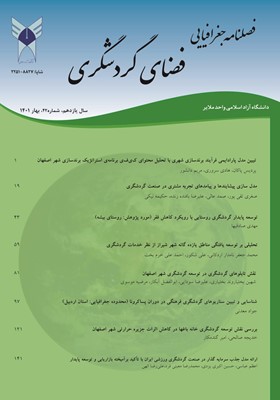مولفه های برندسازی شهری با تحلیل محتوای کیفی برنامه ی استراتژیک برندسازی شهر اصفهان
محورهای موضوعی : مربوط به گردشگری
پردیس پاکان
1
![]() ,
هادی سروری
2
*
,
مریم دانشور
3
,
هادی سروری
2
*
,
مریم دانشور
3
1 - 1- دانشجوی دکتری گروه شهرسازی، واحد مشهد، دانشگاه آزاد اسلامی، مشهد، ایران
2 - استادیار گروه شهرسازی، واحد مشهد، دانشگاه آزاد اسلامی، مشهد، ایران
3 - استادیار گروه شهرسازی، واحد مشهد، دانشگاه آزاد اسلامی، مشهد، ایران
کلید واژه: تحلیل محتوای کیفی, برند شهری, برنامه استراتژیک برندسازی اصفهان,
چکیده مقاله :
امروزه شهرها به طور فزاینده ای در رقابت با یکدیگر برای جذب گردشگران و سرمایه گذاران و شرکت ها، شهروندان جدید و نیروی کار با ارزش و خلاق هستند که در این میان برند شهر نقش موثری را در جذب و یا دفع اقشار مختلف؛ گردشگران، سرمایه گذاران و استعدادها ایفا میکند، بدین منظور تهیهی برنامه-های راهبردی برندسازی شهری برای بازیابی و ارتقاء برند شهرها باتوجه به ارزش های ذاتی مکان و مسیر توسعهی آتی شهرها ضروری است. در ایران نیز گام های موثری در جهت برندسازی شهرها انجام شده است که می توان به برنامه ی استراتژیک برندسازی شهر اصفهان، شهر تهران، طرح استراتژیک هویت بصری مشهد و کلاردشت اشاره کرد. فلذا مطالعۀ اثرات و ارزیابی طرح های استراتژیک برندسازی شهری می تواند ضمن ارتقاء کیفیت برنامههای استراتژیک برندسازی شهری در ایران، رهنمودی در جهت مانع زدایی و اجرایی شدن کامل برنامه هی پیشنهادی اسناد بالادستی برند شهری باشد. در نتیجه پرداختن به این موضوع که طرحهای استراتژیکی که تا کنون تدوین و اجرا شدند، تا چه اندازه مؤثر و کارآمد بوده اند، بسیار حائز اهمیت است. در این پژوهش با استفاده از روش تحلیل محتوای کیفی به بررسی برنامه استراتژیک و راهبردی برندسازی شهر اصفهان و به تبیین مولفههای برندسازی شهری باتوجه به سند مذکور، پرداخته شده و همچنین ابعاد مورد تاکید و یا مغفول مانده در تدوین و تعیین برند شهر اصفهان شناسایی، تحلیل و ارائه شده است.
Today, cities are increasingly competing with each other to attract more and more tourists, investors and companies, new citizens, and a valuable and creative workforce. However, city branding plays an effective role to attract or repel them. Therefore, preparing strategic urban branding plans to recover and promote the brand of cities is of great importance. In Iran, some efforts in this regard such as the strategic branding plan of Isfahan, Tehran, and the strategic plan of the visual identity of Mashhad and Kelardasht have been made. Therefore, studying the effects and evaluation of strategic urban branding plans can improve the quality of strategic city branding programs in Iran. As a result, studying the effectiveness and efficiency of these strategic plans is of high importance. In this research, the qualitative content analysis method was used to study the strategic branding plan of Isfahan and identify the components of urban branding according to the existing documents. To do so, the emphasized or neglected dimensions were identified and presented in Isfahan’s branding. The purpose of this study is to determine the components of city branding and the way the dimensions of the subject are emphasized or neglected in the existing document.
_||_

